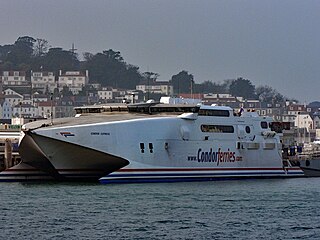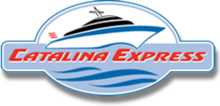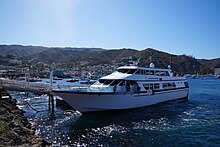A ferry is a ship, watercraft or amphibious vehicle used to carry passengers, and sometimes vehicles and cargo, across a body of water. A passenger ferry with many stops, such as in Venice, Italy, is sometimes called a water bus or water taxi.

Avalon is the only incorporated city on Santa Catalina Island, in the California Channel Islands, and the southernmost city in Los Angeles County. The city is a resort community with the waterfront dominated by tourism-oriented businesses. The older parts of the town on the valley floor consist primarily of small houses and two and three-story buildings in various traditional architectural styles.

Bay Ferries Limited, or simply, Bay Ferries, is a ferry company operating in eastern Canada and is headquartered in Charlottetown, Prince Edward Island, Canada. It is a subsidiary of Northumberland Ferries Limited and a sister company to the defunct Bay Ferries Great Lakes Limited.

A water taxi or a water bus is a watercraft used to provide public or private transport, usually, but not always, in an urban environment. Service may be scheduled with multiple stops, operating in a similar manner to a bus, or on demand to many locations, operating in a similar manner to a taxi. A boat service shuttling between two points would normally be described as a ferry rather than a water bus or taxi.

Shun Tak-China Travel Ship Management Limited, doing business as TurboJET, is a ferry company based in Hong Kong. The company was established from the joint venture between Shun Tak Holdings and China Travel International Investment Hong Kong in July 1999. It operates hydrofoil ferry services between Hong Kong, Macau, Shenzhen and Zhuhai, in the Pearl River Delta area.

Two Harbors, colloquially known as "The Isthmus", is a small unincorporated community island village on the island of Santa Catalina Island, California, with a population of 298. It is the second center of population on the island, besides the city of Avalon. It is mainly a resort village. It has only one restaurant, one hotel and one general store. The village has about 150 permanent residents who live on the isthmus year-round. One notable feature was the one-room schoolhouse which closed in 2014.

New York Water Taxi (NYWT) is a water taxi service based in New York City. It offers sightseeing, charter and commuter services mainly to points along the East River and Hudson River. It is one of several private operators of ferries, sightseeing boats, and water taxis in the Port of New York and New Jersey. It is estimated that 100,000 people ride New York ferries everyday.

The Catalina Flyer is a 500-passenger catamaran ferry operated by Catalina Passenger Service.

Condor Ferries is an operator of passenger and freight ferry services between The United Kingdom, Bailiwick of Guernsey, Bailiwick of Jersey and France.

San Francisco Bay in California has been served by ferries of all types for over 150 years. John Reed established a sailboat ferry service in 1826. Although the construction of the Golden Gate Bridge and the San Francisco–Oakland Bay Bridge led to the decline in the importance of most ferries, some are still in use today for both commuters and tourists.
Fred. Olsen Express is an inter-island ferry service based in the Canary Islands, Spain. It operates a fleet of six modern fast ferries on five routes. Its fleet includes a trimaran fast ferry, the Benchijigua Express, which was the first such vehicle in the world when it entered service in 2005. The company is owned by the Olsen family-controlled Bonheur and Ganger Rolf, which among other things also owns the shipping companies Fred. Olsen Cruise Lines and First Olsen Tankers.

SeaStreak is a private ferry company operating in the Port of New York and New Jersey and in New England. It provides high-speed commuter service between points on the Raritan Bayshore in Monmouth County, New Jersey and in Manhattan in New York City as well as special event and sightseeing excursions in the harbor and seasonal service to the New England coast.

The HSC Virgen de Coromoto is an 86 m (282 ft) fast catamaran ferry operated by Consolidada de Ferrys C.A. in Venezuela. It was built in Australia in 2004 for a fast ferry service on Lake Ontario between Toronto, Ontario, Canada and Rochester, New York, United States. After the ferry service failed, the boat was sold in 2007 and operated in the Strait of Gibraltar on a Spain-Morocco service until 2012. In 2012–13, the ship operated on Kattegatruten's Aarhus–Kalundborg route in Denmark until October 2013 when the route was cancelled.

SS Catalina, also known as The Great White Steamer, was a 301-foot steamship built in 1924 that provided passenger service on the 26-mile passage between Los Angeles and Santa Catalina Island from 1924 to 1975. According to the Steamship Historical Society of America, Catalina has carried more passengers than any other vessel anywhere. From August 25, 1942 until April 22, 1946 the ship served as the Army troop ferry U.S. Army FS-99 at the San Francisco Port of Embarkation transporting more than 800,000 troops and other military personnel between embarkation camps and the departure piers. After a period of service as a floating discothèque, the ship ran aground on a sandbar in Ensenada Harbor in 1997 and partially sank on the spot. It was scrapped in 2009.

Santa Catalina Island is a rocky island off the coast of Southern California in the Gulf of Santa Catalina. The island name is often shortened to Catalina Island or just Catalina. The island is 22 mi (35 km) long and 8 mi (13 km) across at its greatest width. The island is located about 29 mi (47 km) south-southwest of Long Beach, California. The highest point on the island is Mount Orizaba. Geologically, Santa Catalina is part of the Channel Islands of California archipelago and is the easternmost of the Channel Islands. Politically, Catalina Island is part of Los Angeles County in District 4. Most of the land on the island is unincorporated.
Hornblower Cruises & Events NOW City Experiences is a San Francisco-based charter yacht, dining cruise and ferry service company.

The SuperCat Fast Ferry Corporation, commonly known as SuperCat, is a shipping company that operates a fleet of high-speed catamarans (HSC) in the Philippines. It is now part of Chelsea Logistics Holdings Corporation. Supercat was previously the sister company of SuperFerry, Cebu Ferries and 2GO Travel. Supercat operated 7 vessels in 7 ports around the Philippines.

Due to its unique geography, being made of two peninsulas surrounded by the Great Lakes, Michigan has depended on many ferries for connections to transport people, vehicles and trade. The most famous modern ferries are those which carry people and goods across the Straits of Mackinac to the car-free Mackinac Island but before the Mackinac Bridge was built, large numbers of ferries carried people and cars between the two peninsulas. Other ferries continue to provide transportation to small islands and across the Detroit River to Canada. Ferries once provided transport to island parks for city dwellers. The state's only national park, Isle Royale cannot be reached by road and is normally accessed by ferry. The largest ferries in Michigan are the car ferries which cross Lake Michigan to Wisconsin. One of these, the SS Badger is one of the last remaining coal steamers on the Great Lakes and serves as a section of US Highway 10 (US 10). The Badger is also the largest ferry in Michigan, capable of carrying 600 passengers and 180 autos.

Kitsap Fast Ferries is a passenger ferry service operating between Seattle and Kitsap County in the U.S. state of Washington. It is funded and operated by Kitsap Transit and began service in July 2017, with a single boat traveling between Seattle and Bremerton. A second route, from Seattle to Kingston, launched in November 2018, and a third route serving Seattle and Southworth began operating in March 2021. In 2021, the system had a ridership of 573,200, or about 2,900 per weekday as of the second quarter of 2022.



















